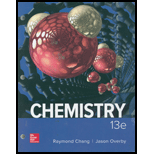
CHEMISTRY (LOOSELEAF) >CUSTOM<
13th Edition
ISBN: 9781264348992
Author: Chang
Publisher: MCGRAW-HILL HIGHER EDUCATION
expand_more
expand_more
format_list_bulleted
Concept explainers
Textbook Question
Chapter 25, Problem 25.28QP
Proteins vary widely in structure, whereas
Expert Solution & Answer
Want to see the full answer?
Check out a sample textbook solution
Students have asked these similar questions
For a weak acid AcH, calculate the dissociated fraction (alpha), if its concentration is 1.540 mol L-1 and the concentration [H+] is 5.01x10-4 mol L-1.
If the molar conductivity at infinite dilution of HAC is A0 = 390.5 S cm² mol¹. Calculate
the Arrhenius conductivity of a 9.3% by weight solution of HAc with a pH of 3.3. Data:
molecular weight of HAC is 60.05 g/mol and the density of the solution is 1 g/cm³.
If the molar conductivity at infinite dilution of HAC is A0 = 390.5 S cm² mol¹. Calculate
the Arrhenius conductivity of a 9.3% by weight solution of HAc with a pH of 3.3. Data:
molecular weight of HAC is 60.05 g/mol and the density of the solution is 1 g/cm³.
Chapter 25 Solutions
CHEMISTRY (LOOSELEAF) >CUSTOM<
Ch. 25 - Prob. 25.1QPCh. 25 - Prob. 25.2QPCh. 25 - Prob. 25.3QPCh. 25 - Prob. 25.4QPCh. 25 - Prob. 25.5QPCh. 25 - Prob. 25.6QPCh. 25 - Prob. 25.7QPCh. 25 - Prob. 25.8QPCh. 25 - Prob. 25.9QPCh. 25 - Prob. 25.10QP
Ch. 25 - Prob. 25.11QPCh. 25 - Prob. 25.12QPCh. 25 - Prob. 25.13QPCh. 25 - Prob. 25.14QPCh. 25 - Prob. 25.15QPCh. 25 - Prob. 25.16QPCh. 25 - Prob. 25.17QPCh. 25 - Prob. 25.18QPCh. 25 - Prob. 25.19QPCh. 25 - Prob. 25.20QPCh. 25 - Prob. 25.21QPCh. 25 - Prob. 25.22QPCh. 25 - Prob. 25.23QPCh. 25 - Prob. 25.24QPCh. 25 - Prob. 25.25QPCh. 25 - Prob. 25.26QPCh. 25 - Discuss the importance of hydrogen bonding in...Ch. 25 - Proteins vary widely in structure, whereas nucleic...Ch. 25 - Prob. 25.29QPCh. 25 - Prob. 25.30QPCh. 25 - Prob. 25.31QPCh. 25 - Prob. 25.32QPCh. 25 - Prob. 25.33QPCh. 25 - Prob. 25.34QPCh. 25 - Prob. 25.35QPCh. 25 - Chemical analysis shows that hemoglobin contains...Ch. 25 - Prob. 25.37QPCh. 25 - What kind of intermolecular forces are responsible...Ch. 25 - Draw structures of the nucleotides containing the...Ch. 25 - Prob. 25.40QPCh. 25 - Prob. 25.41QPCh. 25 - Prob. 25.42QPCh. 25 - Prob. 25.43QPCh. 25 - Prob. 25.44QPCh. 25 - When deoxyhemoglobin crystals are exposed to...Ch. 25 - Prob. 25.46QPCh. 25 - Prob. 25.47QPCh. 25 - Prob. 25.48QPCh. 25 - Prob. 25.49QPCh. 25 - Prob. 25.50QPCh. 25 - Prob. 25.51QPCh. 25 - Assume the energy of hydrogen bonds per base pair...Ch. 25 - Prob. 25.53QP
Knowledge Booster
Learn more about
Need a deep-dive on the concept behind this application? Look no further. Learn more about this topic, chemistry and related others by exploring similar questions and additional content below.Similar questions
- If the molar conductivity at infinite dilution of HAC is A0 = 390.5 S cm² mol¹. Calculate the Arrhenius conductivity of a 9.3% by weight solution of HAc with a pH of 3.3. Data: molecular weight of HAC is 60.05 g/mol and the density of the solution is 1 g/cm³.arrow_forwardDetermine the distance between the metal and the OHP layer using the Helm- holtz model when the electrode's differential capacitance is 145 μF cm². DATA: dielectric constant of the medium for the interfacial zone &r= lectric constant of the vacuum &0 = 8.85-10-12 F m-1 = 50, die-arrow_forwardDescribe a sequence of photophysical processes that can be followed by radiation adsorbed by a molecule in the ground state to give rise to phosphorescent emission.arrow_forward
- State two similarities between fluorescence and phosphorescence.arrow_forwardState three photophysical processes that can be related to the effects of incident radiation on a molecule in its ground state. Consider that radiation can give rise to fluorescent emission, but not phosphorescent emission.arrow_forwardIn a photochemical reaction, how is the rate of the process related to its quantum yield?arrow_forward
arrow_back_ios
SEE MORE QUESTIONS
arrow_forward_ios
Recommended textbooks for you
 World of Chemistry, 3rd editionChemistryISBN:9781133109655Author:Steven S. Zumdahl, Susan L. Zumdahl, Donald J. DeCostePublisher:Brooks / Cole / Cengage Learning
World of Chemistry, 3rd editionChemistryISBN:9781133109655Author:Steven S. Zumdahl, Susan L. Zumdahl, Donald J. DeCostePublisher:Brooks / Cole / Cengage Learning World of ChemistryChemistryISBN:9780618562763Author:Steven S. ZumdahlPublisher:Houghton Mifflin College Div
World of ChemistryChemistryISBN:9780618562763Author:Steven S. ZumdahlPublisher:Houghton Mifflin College Div ChemistryChemistryISBN:9781305957404Author:Steven S. Zumdahl, Susan A. Zumdahl, Donald J. DeCostePublisher:Cengage Learning
ChemistryChemistryISBN:9781305957404Author:Steven S. Zumdahl, Susan A. Zumdahl, Donald J. DeCostePublisher:Cengage Learning Chemistry: An Atoms First ApproachChemistryISBN:9781305079243Author:Steven S. Zumdahl, Susan A. ZumdahlPublisher:Cengage Learning
Chemistry: An Atoms First ApproachChemistryISBN:9781305079243Author:Steven S. Zumdahl, Susan A. ZumdahlPublisher:Cengage Learning Chemistry: Matter and ChangeChemistryISBN:9780078746376Author:Dinah Zike, Laurel Dingrando, Nicholas Hainen, Cheryl WistromPublisher:Glencoe/McGraw-Hill School Pub Co
Chemistry: Matter and ChangeChemistryISBN:9780078746376Author:Dinah Zike, Laurel Dingrando, Nicholas Hainen, Cheryl WistromPublisher:Glencoe/McGraw-Hill School Pub Co

World of Chemistry, 3rd edition
Chemistry
ISBN:9781133109655
Author:Steven S. Zumdahl, Susan L. Zumdahl, Donald J. DeCoste
Publisher:Brooks / Cole / Cengage Learning

World of Chemistry
Chemistry
ISBN:9780618562763
Author:Steven S. Zumdahl
Publisher:Houghton Mifflin College Div

Chemistry
Chemistry
ISBN:9781305957404
Author:Steven S. Zumdahl, Susan A. Zumdahl, Donald J. DeCoste
Publisher:Cengage Learning

Chemistry: An Atoms First Approach
Chemistry
ISBN:9781305079243
Author:Steven S. Zumdahl, Susan A. Zumdahl
Publisher:Cengage Learning


Chemistry: Matter and Change
Chemistry
ISBN:9780078746376
Author:Dinah Zike, Laurel Dingrando, Nicholas Hainen, Cheryl Wistrom
Publisher:Glencoe/McGraw-Hill School Pub Co
Biomolecules - Protein - Amino acids; Author: Tutorials Point (India) Ltd.;https://www.youtube.com/watch?v=ySNVPDHJ0ek;License: Standard YouTube License, CC-BY